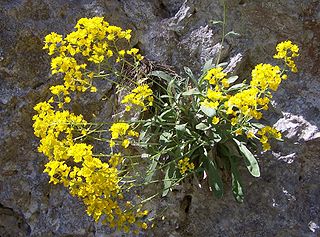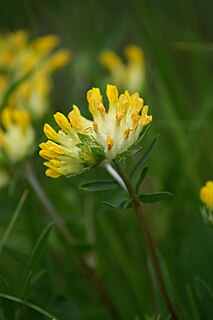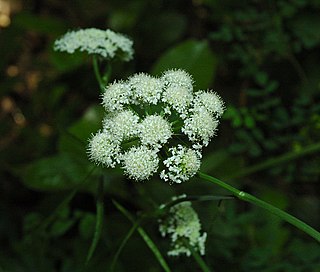
Nepeta is a genus of flowering plants in the family Lamiaceae. The genus name is reportedly in reference to Nepete, an ancient Etruscan city. There are about 250 species.

Clover or trefoil are common names for plants of the genus Trifolium, consisting of about 300 species of flowering plants in the legume or pea family Fabaceae originating in Europe. The genus has a cosmopolitan distribution with highest diversity in the temperate Northern Hemisphere, but many species also occur in South America and Africa, including at high altitudes on mountains in the tropics. They are small annual, biennial, or short-lived perennial herbaceous plants, typically growing up to 30 cm tall. The clover is the color of evergreen. The leaves are trifoliate, cinquefoil, or septfoil, with stipules adnate to the leaf-stalk, and heads or dense spikes of small red, purple, white, or yellow flowers; the small, few-seeded pods are enclosed in the calyx. Other closely related genera often called clovers include Melilotus and Medicago.

Nonea is a genus of flowering plants in the borage family Boraginaceae. Sometimes known as monkswort, these are herbaceous perennials or annual plants, native to Europe, Asia and Africa.

Verbascum, common name mullein, is a genus of about 360 species of flowering plants in the figwort family Scrophulariaceae. They are native to Europe and Asia, with the highest species diversity in the Mediterranean.

Reseda, also known as the mignonette, is a genus of fragrant herbaceous plants native to Europe, southwest Asia and North Africa, from the Canary Islands and Iberia east to northwest India. The genus includes herbaceous annual, biennial and perennial species 40–130 cm tall. The leaves form a basal rosette at ground level, and then spirally arranged up the stem; they can be entire, toothed or pinnate, and range from 1–15 cm long. The flowers are produced in a slender spike, each flower small, white, yellow, orange, or green, with four to six petals. The fruit is a small dry capsule containing several seeds.

Fumaria is a genus of about 60 species of annual flowering plants in the family Papaveraceae. The genus is native to Europe, Africa and Asia, most diverse in the Mediterranean region, and introduced to North, South America and Australia. Fumaria species are sometimes used in herbal medicine. Fumaria indica contains the alkaloids fuyuziphine and alpha-hydrastine. Fumaria indica may have anti-inflammatory and analgesic potential.

Aurinia is a genus of flowering plants of the family Brassicaceae (Cruciferae), native to mountainous areas of Central and Southern Europe, Russia and Turkey. They are closely related to Alyssum, which they resemble. They can either be biennial or woody-based evergreen perennials. They produce panicles of yellow flowers in early summer.

Petrorhagia is a small genus of annual and perennial plants of the family Caryophyllaceae, mostly native to the Mediterranean region. The genus is often referred to as Tunica, which is an obsolete synonym. It is low-growing with wiry stems and narrow, grass-like leaves. The flowers are small, in clusters similar to members of the genus Dianthus, in pink, lilac, or white. Petrorhagia saxifraga is the tunic flower or coat flower, similar to baby's breath, but shorter, and used in rock gardens.

Anthyllis is a genus of flowering plants in the family Fabaceae. This genus contains both herbaceous and shrubby species and is distributed in Europe, the Middle East and North Africa. The most widespread and familiar species is A. vulneraria, a familiar grassland flower which has also been introduced to New Zealand.

Asperula, commonly known as woodruff, is a genus of flowering plants in the family Rubiaceae. It contains about 195 species and has a wide distribution area from Europe, northern Africa, temperate and subtropical Asia to Australasia.

Bunium is a genus of flowering plants in the family Apiaceae, with 45 to 50 species.
Trigonosciadium is a genus of five species in the Apiaceae. Trigonosciadium brachytaenium is endemic to Iran, whereas T. tuberosum and T. viscidulum grow in Iran, Anatolia and Iraq.

Allium sindjarense is a species of flowering plant in the Amaryllidaceae family.

Noccaea is a problematic genus of flowering plants in the family Brassicaceae, native to temperate areas of western North America, southern South America, northern Africa, Europe and Asia.

Hormathophylla is a genus of flowering plants in the family Brassicaceae, native to the western Mediterranean; Morocco, Algeria, Spain, France and Italy. Perennial shrubs, they are adapted to dry, alkaline soils with high levels of magnesium.
Caropodium is a genus of flowering plants belonging to the family Apiaceae.
Bufonia is a genus of flowering plants belonging to the family Caryophyllaceae.
Clastopus is a genus of flowering plants belonging to the family Brassicaceae.













